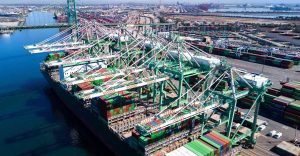Kobe Port, located in the city of Kobe, Hyogo Prefecture, Japan, is one of the largest and oldest seaports in Japan, with a history dating back to the 19th century. Kobe Port is not only an important cargo transportation hub for Japan but also for the Asia-Pacific region and the world. This port plays a crucial role in the global supply chain, particularly in connecting Japan with international markets.
Geographical Location and Infrastructure of Kobe Port
Geographical Location
Kobe Port is located in the Osaka Bay area and borders the Seto Inland Sea, a strategic location that allows the port to easily connect with international shipping routes and other key economic areas of Japan.
Infrastructure
The infrastructure of Kobe Port is heavily invested in, featuring modern docks, warehouse systems, and advanced logistics services. The port can accommodate large container ships and is equipped with modern cargo handling equipment, ensuring quick and efficient cargo transport.
Trade Activities and Shipping Data
Cargo Volume
According to a report from Mordor Intelligence, the total cargo volume transported through Kobe Port annually reaches around 80 million tons. Major items include industrial goods, agricultural products, and consumer goods. Kobe Port has focused on improving operational efficiency and adopting modern technologies to reduce costs and increase cargo handling speed.
International Connections
Kobe Port connects with over 500 seaports worldwide, facilitating the smooth flow of goods and boosting international trade. Japan has one of the most developed port systems in the world, and Kobe Port plays a significant role in this development.
Trade Relations with Vietnam
Export and Import Turnover
Vietnam is one of the important trade partners of Kobe Port. According to data from the General Statistics Office of Vietnam, trade turnover between Vietnam and Japan has been steadily growing, with the majority of goods transported through Kobe Port. Major exports from Vietnam include textiles, agricultural products, and seafood, while Japan exports machinery, electronics, and automobiles to Vietnam.
Economic Contribution
Trade between Kobe Port and Vietnam not only strengthens the trade relations between the two countries but also makes a significant contribution to the economies of both nations. Kobe Port serves as an important gateway for Vietnamese businesses to access the Japanese market and vice versa.
The Role of Kobe Port in the Global Supply Chain
Center for Cargo Transport
Kobe Port plays an important role in the global supply chain, especially in the Asia-Pacific region. By adopting modern logistics solutions and providing comprehensive support services, the port has facilitated the smooth flow of goods and the growth of international trade. Logistics experts believe that Kobe Port will continue to maintain its position as a key cargo transport hub in the future.
Sustainable Development
Kobe Port is focusing on sustainable development by implementing environmental protection measures and enhancing energy efficiency. Infrastructure upgrade projects and the adoption of green technologies are being carried out to minimize environmental impacts and ensure the sustainable growth of the port.
Challenges and Prospects
Despite achieving significant progress, Kobe Port also faces challenges such as competition from other ports in the region and pressure to improve infrastructure and services. Ensuring maritime security and managing natural disaster risks are also among the major challenges for Kobe Port.
With a strategy for sustainable development and strong investment from the government and businesses, Kobe Port is expected to grow even further in the coming years. The growth of logistics and e-commerce industries also opens up new opportunities for Kobe Port.
Kobe Port is not only a critical destination for international cargo transport activities but also plays a key role in the trade relationship between Japan and Vietnam. With the continuous development of logistics and e-commerce, Kobe Port is poised to remain an essential link in the global supply chain.






